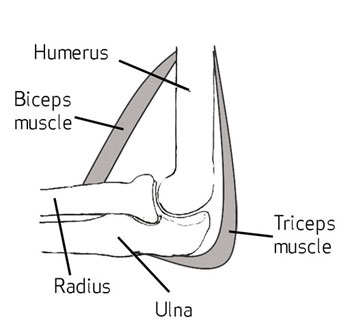Resources
Resource 1: Antagonistic muscles
Muscles work by getting shorter. We say that they contract, and the process is called contraction.
Muscles are attached to bones by strong tendons. When a muscle contracts, it pulls on the bone, and the bone can move if it is part of a joint.
Muscles can only pull and cannot push. This would be a problem if a joint were controlled by just one muscle: as soon as the muscle contracted and pulled on a bone, it would not be able to move the bone back again. The problem is solved by having muscles in pairs, called antagonistic muscles.
The elbow joint (Figure R1.1) lets our forearm move up or down. It is controlled by two muscles on the upper arm: the biceps on the front and the triceps on the back. The biceps and the triceps are antagonistic muscles.
- When the biceps muscle contracts, the forearm moves up.
- When the triceps muscle contracts, the forearm moves down.
Figure R1.1 A model of a hinge joint.
5 Summary

